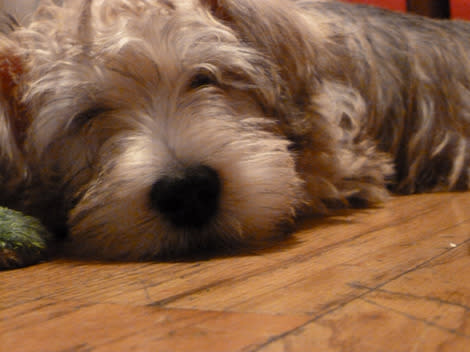Puppy Parenting: 7 Tips for Raising a New Pet
I'm excited to announce that I've recently became a pet parent! Meet my 13-week-old puppy, Chip. He was born in Bartonsville, PA, along with seven other siblings. My boyfriend and I adopted him when he was 8 weeks old. His dad is a Schnauzer and his mom is a Maltese-Poodle. So that would make him a … Schnauzer Maltipoo? Schnoodle Maltese? Schnautese Poodle? Whatever he is, he sure is one cute little puppy.
I grew up with a whole bunch of dogs and cats running around the house. But I was too young at the time to take care of them, so my parents basically did all the dirty work. (Yes, including giving our Pomeranian a buzz cut). Which means I had no idea of the extent to which raising a puppy is a 24-7 job. But similar to what it's like with children, coming home to see Chip's sweet little face and waggly tail makes everything totally worth it - until you come home and realize he has, uh, "done his business" all over the place. Then it's a whole different story.
I figured, with all my "new pet parent" knowledge, I might as well share some pointers. So, if you're thinking about bringing home a young puppy right from the breeder for the first time, here's what we did/have been doing with Chip:
Related: 10 best small dog breeds for families
1. Get some basic information from the breeder: The breeds of the parents and their weights, vaccine status (if the puppy has had any), the puppy's birthday, and, of course, the breeder's contact information. It's always good to have some paperwork just in case, especially for medical purposes.
2. Try to bring your puppy to the vet as soon as you can. If the puppy hasn't had any vaccinations, the vet can give you an idea of what is required and when to get them. Also, start logging your puppy's health and behavior. If he's acting a little unusual, write it down and see if it's a recurring thing.
3. Designate an area that your puppy knows as his "room." A place where he does most of his activities, including resting, eating, playing, and hiding. Dogs are den animals, so get him a crate that he feels safe in and can call his own. You want to create a comfortable space for him because it will help with his separation anxiety (yes, like babies, dogs have separation anxiety!).
Related: Potty training--5 reasons why training a pet is easier than training a kid
4. Be prepared with all things your puppy will need and save money in your budget for "extras." Do some homework on what kind of water bowl is best for his size, what kind of play pen works within your space and fits your budget, etc. (And soon you'll find yourself reading product reviews past midnight).
5. Put your puppy on a schedule. Keeping a structured daily routine for your pup is important because it will make him feel more secure and behave properly. When there isn't a schedule, he won't know when to expect a meal or what comes before and after that. This may also mean adjustments to your own schedule, like going to bed half an hour earlier so you can wake up earlier to walk him in the morning, spending time to train and play with him, and so on. Sticking to a new schedule is a big commitment, but hey, that's all part of the package!
6. Keep him busy while you're gone. Every time you leave your puppy for long periods of time (heading out to dinner, leaving for work, going to the store), give him something that he can spend time on while you're gone, like a Kong toy. I like to stuff it and freeze it with plain yogurt, peanut butter, or even baby food. Also, have a few toys that you can rotate each day so he doesn't get bored with playing with the same one. What does a puppy do when he gets bored? All kinds of bad things we won't want to come home to. (Hint: keep your shoes out of reach)! More importantly, whether or not you are already allowed to walk him outside, tire him out enough so he doesn't have extra energy to cause trouble in your absence.
Related: The top 10 most popular dog breeds of 2012

7. Do your research! Read, read, and read some more on how to train your puppy and do it right from the start. Teach him simple commands, like "sit," "come," "leave it," and "off." Training takes knowledge, patience, and time (and also depends on how good of a teacher you are …). Get into the habit of leading training sessions before playtime (make it part of the routine). Just like trying to decide which crate to buy, you'll find training research endless but interesting.
- By Kayiu Ho
Follow Kayiu on Babble
For 3 more tips on raising your pet, visit Babble!
MORE ON BABBLE
9 animal photos that will melt your heart
25 hilarious awkward family pet photos
12 dog-friendly treats you can make at home
25 horrifying photos of things pets have ruined
The 12 strangest family pets from around the world
